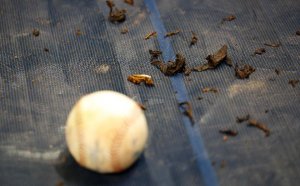
Where did chewing Tobacco originate?
Once considered a harmless pleasure, smokeless tobacco came to the forefrontof health news at the turn of the millennium due to increasing evidence thatit is just as dangerous as cigarette smoking. In fact, most medical professionals now agree that smokeless tobacco-also known as "chaw" or "chew"-is equally addictive and carcinogenic, and have come to consider the substance as contributing to the U.S. tobacco epidemic. Despite the medical community's efforts to warn people beginning in the mid-1980s, the use of smokeless tobaccowas on the rise as of the U.S. Surgeon General's report in 1997, which pinpointed young males as the largest growth area. Adolescent use of moist snuff, apowdered form of smokeless tobacco, has also skyrocketed, rising 1, 500 percent between 1970 and 1991. As of 1995, 2.9 percent of Americans used some formof smokeless tobacco. From 1998 to 1999, the production of snuff rose eightpercent, even in the face of increased health warnings and tax hikes.
A History
Smokeless tobacco made its debut in the United States in about 1611, when itappeared in Virginia's new Jamestown Colony, although it had already been used all over the world for many centuries. For instance, as early as 3500 B.C., people in Peru and Mexico used tobacco (both chewed or smoked) and there are records indicating that they regarded it as a valuable, tradable substance. In the colonial United States, it first took the form of "snuff, " a dry powder inhaled through the nose. There are no records of tobacco chewing in the United States until almost a century later.
The topic of smokeless tobacco has always been a matter of heated debate. Until quite recently, many people believed it to be beneficial to health. One reason for this may have been that people with not enough food to eat found that chewing tobacco alleviated their hunger pains. Some Native American peoplesused it to relieve toothaches; treat insect, snake, and spider bites; and disinfect minor wounds. In addition, in the United States in the 1800s and early 1900s, snuff was thought to soothe toothaches; whiten teeth and stave off decay; and cure bleeding gums, scurvy, and neuralgia. Indeed, even in modern times, some people continue to use tobacco to reduce appetite, relieve boredomand stress, and allay unpleasant feelings.
There were plenty of adherents to the opposite camp, however, who maintainedthat chewing tobacco was a vile, unhealthy practice. Indeed, many rulers during the 1600s and 1700s banned its use and promised severe punishment of anyone caught using it. For example, in 1683 in China, anyone even possessing tobacco could be beheaded, while France's Louis XV banned snuff from his court during 1723 to 1774. Scotland's King James VI raised taxes on tobacco by 4, 000percent in the early 1600s to reduce its use, and in 1633 Turkey's Sultan Murad IV, stating that tobacco use caused infertility and a decline in the performance of his soldiers, made using any form of tobacco a capital offense. Bythe end of the 19th century, antispitting laws were in force in most areas ofthe United States, indicting smokeless tobacco's loss of social acceptability. It would rapidly be replaced by cigarettes.
It was not until 1761, however, that any scientific observations were made about chewing tobacco and its effects on health. London physician John Hill noticed and reported the occurrence of nasal "polypuses" (now known as polyps, atumor on a stem-like extension) in some of his patients who chewed tobacco.He concluded that these "hard, black" tumors were the direct result of inhaling snuff. It took until 1915 for physicians in the United States and Europe to begin drawing the same conclusion about snuff and chewing tobacco as they witnessed increasing numbers of tobacco-using patients coming to them with oral and nasal cancers. Despite all this evidence of the ill effects of smokeless tobacco, though, the United States did not carry out an epidemiological study on the substance until the early 1950s and the Surgeon General did not doa report on the issue until 1979.
Why Smokeless Tobacco Is So Addictive
Smokeless tobacco, like cigarettes, is highly addictive because it contains nicotine. Some researchers have found evidence that nicotine is even more addictive than heroin, so it is no wonder that people are easily "hooked" on tobacco products and have a hard time quitting them. Nicotine is what produces the relaxing effect that tobacco users crave and come to expect. With the chemical symbol C10H14N2, nicotine is an alkaloidderived from pyridine, a carcinogenic poison that occurs naturally in coal tar. The drug works through the central nervous system, binding (filling emptyslots) with nicotinic receptors located in the brain's dopaminergic neurons(dopamine-sensitive nerve cells), causing the neurons to release more dopamine.
VIDEO REVIEWS



Share this Post
Related posts
History of chewing tobacco
Lenny Dykstra chews tobacco during a game against the Chicago Cubs, Sept 1, 1990. Credit: Jonathan Daniel / Getty Images…
Read MoreTobacco history facts
Nicotine was isolated from tobacco leaves ( Nicotiana tabacum ) in 1828, but the powerful effects of nicotine were already…
Read More










